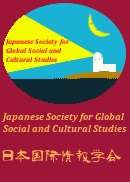Volume 2, Issue 1
The Journal of Japanese Society for Global Social and Cultural Studies 2_1
Displaying 1-5 of 5 articles from this issue
- |<
- <
- 1
- >
- >|
Original2005
-
2005Volume 2Issue 1 Pages 1-12
Published: June 18, 2005
Released on J-STAGE: January 02, 2017
Download PDF (63K) -
2005Volume 2Issue 1 Pages 13-24
Published: June 18, 2005
Released on J-STAGE: January 02, 2017
Download PDF (62K) -
2005Volume 2Issue 1 Pages 25-36
Published: June 18, 2005
Released on J-STAGE: January 02, 2017
Download PDF (80K) -
2005Volume 2Issue 1 Pages 37-49
Published: June 18, 2005
Released on J-STAGE: January 02, 2017
Download PDF (131K) -
2005Volume 2Issue 1 Pages 50-61
Published: June 18, 2005
Released on J-STAGE: January 02, 2017
Download PDF (75K)
- |<
- <
- 1
- >
- >|
